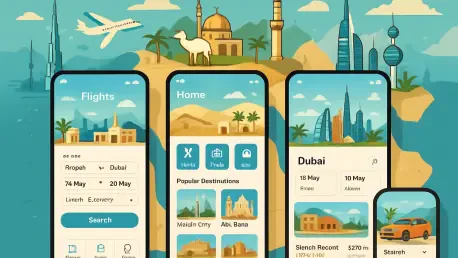The Gulf Cooperation Council (GCC) region, encompassing Bahrain, Kuwait, Oman, Qatar, Saudi Arabia, and the UAE, stands at the forefront of a digital revolution in travel and tourism, driven by ambitious initiatives like the Unified GCC Tourist Visa and Saudi Arabia’s Vision 2030. This transformation is not just a trend but a strategic push to position the region as a global leader in innovative travel experiences. With tourism booming across iconic destinations—from the desert expanses of Saudi Arabia to the futuristic skylines of Dubai and Doha—there is a surging demand for mobile apps that deliver seamless, personalized solutions. According to Statista, the MENA region’s travel and tourism market is expected to reach $4.80 billion by 2030, signaling vast opportunities for tech-driven solutions. As travelers increasingly turn to smartphones for planning and booking, the need for apps tailored to regional preferences and cultural nuances becomes paramount. This article delves into the critical aspects of developing next-generation travel apps for the GCC, exploring the process, essential features, cost considerations, and unique challenges faced in this dynamic market.
1. Understanding the Digital Travel Surge in the GCC
The GCC is undergoing a profound shift in how travel and tourism are experienced, largely due to government-led digitalization efforts. Initiatives such as Saudi Arabia’s Vision 2030 and the UAE’s Tourism Strategy 2040 aim to integrate technology into every facet of the travel journey, from online visa applications to streamlined border crossings. A prime example is the Unified GCC Tourist Visa, which simplifies multi-country travel across the six nations through a single digital permit. Additionally, the UAE’s collaboration with UN Tourism to develop a digital communication platform for member countries underscores a commitment to modernizing the sector. These efforts create fertile ground for app developers to craft solutions that align with regional goals, enhancing accessibility and convenience for millions of visitors and residents alike.
Beyond governmental pushes, the region’s startup ecosystem is playing a pivotal role in shaping the digital travel landscape. With over 150 travel-related startups in the UAE alone, innovative mobile solutions are emerging to cater to diverse traveler needs. These range from booking platforms to personalized trip planners, often leveraging cutting-edge technologies like AI and mobile-first designs. The focus on integrating local services ensures that apps resonate with the GCC audience, offering features that reflect cultural and logistical realities. As technology continues to redefine travel in the region, developers have a unique opportunity to set new benchmarks for efficiency and personalization, meeting the expectations of a tech-savvy population and a growing influx of international tourists.
2. Navigating the Step-by-Step Development Process for GCC Travel Apps
Developing a travel app for the GCC market requires a structured approach to ensure it meets regional demands and user expectations. The first step is a comprehensive market analysis and needs assessment, where developers must study existing apps to identify gaps and opportunities. Creating detailed user profiles helps in understanding what GCC travelers prioritize, whether it’s ease of booking or culturally relevant content. Additionally, reviewing local regulations, preferred payment systems, and user habits is essential to avoid pitfalls during development. This foundational research ensures that the app aligns with both market needs and legal requirements, paving the way for a smoother creation process.
The next phase focuses on interface and experience design, a critical element in user satisfaction. Initial sketches and prototypes are developed to map out the app’s functionality, allowing stakeholders to visualize the end product early on. Incorporating design elements that reflect regional aesthetics, alongside multi-language support, ensures accessibility for a diverse user base. An intuitive user interface is non-negotiable, as it directly impacts retention and engagement. By prioritizing user-friendly layouts and culturally adapted designs from the outset, developers can create a product that feels familiar and appealing to GCC travelers, fostering long-term usage.
3. Selecting the Right Tech Framework for Scalability
Choosing the appropriate technology framework is a cornerstone of building a robust travel app for the GCC. For frontend development, options like Flutter, React Native, Swift, or Kotlin offer flexibility depending on the target platforms, whether iOS or Android. Backend solutions such as Node.js or .NET, paired with cloud hosting, are vital for handling scalability, especially during peak travel seasons. Integrating local payment systems like Rakuten Pay or STC, alongside travel service APIs, ensures seamless transactions and real-time updates. This tech selection process directly influences the app’s performance and ability to grow with user demand, a key consideration in a rapidly expanding market.
Beyond the tools, the focus on scalability cannot be overstated in a region expecting significant tourism growth. A well-chosen tech stack supports high traffic without compromising speed or reliability, ensuring users experience consistent service even during busy periods like holidays or festivals. Developers must also prioritize secure integrations to protect user data, particularly when connecting with external booking engines or payment gateways. By aligning technology choices with the region’s digital infrastructure and user expectations, businesses can deliver a travel app that stands out for its efficiency and reliability in the competitive GCC landscape.
4. Executing the App Building and Testing Phases
The app building stage employs agile methodologies, emphasizing regular sprints and continuous testing to maintain high quality throughout development. This phase involves integrating external services such as booking systems, maps, and review platforms to create a comprehensive user experience. Collaboration among developers, designers, and product managers is crucial to ensure the app meets business objectives while addressing the specific needs of GCC travelers. Regular check-ins help identify and resolve issues early, keeping the project on track and aligned with regional expectations for functionality and ease of use.
Once development nears completion, rigorous testing and quality control take center stage. Performance evaluations, security assessments, and cross-platform compatibility checks are conducted to ensure the app operates flawlessly across devices. Identifying and fixing bugs before launch prevents user dissatisfaction and builds trust in the product. Compliance with GCC regulations, especially concerning data protection, is also verified during this phase. Thorough quality assurance delivers a dependable app that travelers can rely on, setting a strong foundation for a successful market entry in a region with high standards for digital solutions.
5. Launching and Maintaining the App for Long-Term Success
The launch phase involves strategic steps like beta testing with a select user group to gather initial feedback, alongside app store optimization to enhance visibility and downloads. A well-executed release maximizes reach in the GCC market, where competition among travel apps is intensifying. Post-launch, continuous monitoring of user interactions and feedback is essential for identifying areas for improvement. Regular updates ensure the app remains relevant, addressing evolving travel trends and user preferences in a dynamic region like the GCC, where tourism continues to expand rapidly.
Maintenance is equally critical to sustain user engagement over time. This includes fixing bugs, enhancing security, and introducing small feature upgrades to keep the app competitive. As travel behaviors shift, ongoing support ensures the app adapts to new demands, whether through improved functionalities or integrations with emerging services. By prioritizing post-launch care, developers can create lasting value, fostering user loyalty in a market where seamless and reliable travel solutions are increasingly sought after by both locals and international visitors exploring the GCC.
6. Essential Features for GCC Travel Apps to Meet User Needs
A next-generation travel app in the GCC must go beyond basic functionality to include features tailored to regional users. Multi-language support, particularly for Arabic and English, is crucial to serve locals, expatriates, and tourists alike. Integration with local payment gateways like Mada and PayTabs ensures secure and convenient transactions, while real-time booking for flights and hotels with instant confirmations adds efficiency. Other must-haves include itinerary management tools, instant notifications for travel updates, and advanced search filters, all of which streamline the planning process for users navigating the region’s diverse destinations.
Additional features like built-in maps for navigation, user feedback systems through ratings and reviews, and access to promotions or discounts further enhance the app’s appeal. Offline functionality stands out as a practical addition, allowing travelers to access itineraries and tickets without internet connectivity—a boon for international visitors. These elements collectively address the practical needs of GCC travelers, ensuring the app not only meets expectations but also builds trust by offering a comprehensive, user-friendly experience that aligns with the region’s unique travel ecosystem and cultural context.
7. Advanced Functionalities for a Competitive Edge in the GCC Market
To stand out in the crowded GCC travel market, apps must incorporate advanced functionalities that elevate the user experience. AI-powered suggestions, tailored to individual preferences and travel history, offer personalized recommendations that resonate with users. Augmented reality tools providing 3D previews of landmarks or hotels create an immersive planning experience, while multi-currency pricing in local denominations like AED or SAR ensures transparency. Intelligent trip planning with automated route and activity suggestions further simplifies travel, catering to the tech-savvy audience in the region.
Beyond personalization, real-time updates on flights and traffic, coupled with gamification elements like rewards or badges, boost engagement and loyalty. Social sharing options allow users to post plans or reviews directly from the app, while tailored notifications keep them informed of relevant offers. AI-driven chat support, available 24/7 in multiple languages, addresses queries swiftly, and a robust analytics dashboard provides insights into user behavior for continuous improvement. These sophisticated features position an app as a leader in the GCC, meeting modern traveler demands with innovation and precision.
8. Breaking Down the Costs of Travel App Development in the GCC
Estimating the cost of developing a travel app in the GCC hinges on several factors, including feature complexity, backend infrastructure, and third-party integrations. A basic app with essential booking and planning tools may range from AED 110,000 to 370,000 ($30,000 to $100,000), while an advanced app with AI, AR, and real-time updates could cost between AED 370,000 and 1,100,000 ($100,000 to $300,000). Annual maintenance, covering updates and bug fixes, typically falls between AED 18,400 and 55,000 ($5,000 to $15,000). Custom designs for regional preferences and compliance with local regulations also influence the budget, requiring careful financial planning.
For specialized or niche apps targeting specific travel segments like luxury or adventure tours, costs can span AED 184,000 to 740,000 ($50,000 to $200,000). Cost-saving strategies include launching a Minimum Viable Product (MVP) to test market demand, balancing in-house and outsourced development, and leveraging pre-built APIs for faster integration. Planning for scalability from the start prevents expensive overhauls later, especially in a region anticipating tourism spikes. Understanding these cost dynamics helps businesses allocate resources effectively, ensuring a high-quality app without unnecessary expenditure in the competitive GCC market.
9. Overcoming Challenges in GCC Travel App Development
Developing a travel app for the GCC presents unique challenges, starting with the diversity of currencies and payment preferences across countries. With currencies like AED, SAR, and QAR in use, seamless transactions are vital to user satisfaction. The solution lies in integrating trusted payment gateways that support multiple currencies and conducting thorough testing to prevent checkout failures. This approach minimizes booking abandonment, a critical factor in ensuring the app’s success among a varied user base spanning locals and international travelers exploring the region.
Regulatory variations across GCC nations pose another hurdle, as each country has distinct rules for data privacy and travel operations. Non-compliance can lead to penalties or app restrictions, so collaborating with legal experts to navigate these frameworks is essential. Data security remains a top concern, given the sensitive information users share. Implementing encryption, secure APIs, and strict access controls, while adhering to regional and international standards, builds trust. Scalability during peak travel seasons also requires a robust backend with cloud hosting and real-time monitoring to maintain performance under high demand, ensuring reliability when it matters most.
10. Shaping the Future of Travel in the GCC Through Innovation
Looking back, the journey of crafting next-generation travel apps for the GCC revealed a landscape rich with opportunity yet demanding meticulous attention to regional nuances. Governments and startups alike have driven a digital wave that transformed tourism, setting high standards for what travelers expect from mobile solutions. The focus on blending technology with cultural understanding proved pivotal in creating apps that resonate deeply with users across the region, from bustling urban hubs to remote desert destinations.
Moving forward, businesses must prioritize actionable strategies to capitalize on this momentum. Partnering with experienced developers can turn visionary ideas into market-ready solutions that redefine travel standards in the GCC. Emphasizing scalability, security, and personalized features will ensure apps remain relevant as tourism grows. Engaging with experts to navigate the complexities of local markets offers a clear path to success, enabling the creation of platforms that not only meet current demands but also anticipate future needs in a region poised for continued digital expansion in travel.









